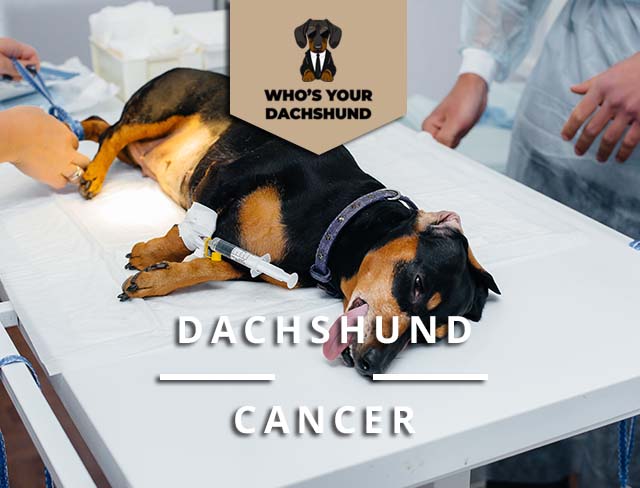
Dachshunds are prone to a form of cancer known as spindle cell sarcoma. This type of cancer is rare in humans but has been identified as the second most popular type of canine neoplasms in Dachshunds. Spindle cell sarcoma is a malignant tumor of the connective tissues that multiply and invades other tissues and organs. Although over 50% of Dachshunds are diagnosed with spindle cell sarcoma, the tumor can be successfully surgically removed if diagnosed early enough. There are very few side effects from surgery, but unfortunately, many dogs do not survive long after diagnosis due to this type of cancer being aggressive. The prognosis for dogs who have undergone surgery is good but not promising. The survival rate for dogs diagnosed with spindle cell sarcoma is 15%-20%.
Other types of Cancer of Dachshunds
Orthopedic Diseases
Orthopedic Disease is a kind of cancer of Dachshund that occurs when a tumor is formed in any part of the body, and the suspected location for most of these cancer types is the spine. These tumors can be benign or malignant and often occur in Dachshunds younger than seven. Cancer can quickly reduce your dog’s ability to move its legs freely, which is one reason why you must find ways to treat it as soon as possible.
Lymphoma
Lymphoma refers to any cancer cells found in lymph nodes or other parts of the body that make up a lymphatic system. More specifically, Lymphoma occurs when there is an uncontrolled growth of malignant tissue involving lymph nodes or other organs and tissues associated with the lymphatic system, such as the stomach and spleen. Lymphoma belongs to the most common forms of cancer in dogs, and Dachshunds are among the breeds that are more liable to get Lymphoma. In this type of cancer, cells develop and grow uncontrollably throughout the body.
Leukemia
Leukemia refers to a disease in which malignant white blood cells abnormally proliferate in blood vessels and interfere with blood production, affecting other organs and tissues through lack of oxygen supply. Leukemia can be found in the bone marrow, spleen, lymph nodes, liver, or kidneys. The risk of getting this type of cancer is highest when dogs are exposed to environmental pollutants such as pesticides or fertilizers.
Squamous Cell Carcinoma
Squamous cell carcinoma, also known as SCC or SCCH, is commonly found in dogs. It’s the most common form of tumor in dogs and has been identified in more than 75% of all common breeds. Squamous cell carcinoma is a fast-growing tumor that spreads rapidly throughout the body, especially into other organs and tissues. It can be fatal if not detected early enough. Early detection and treatment can be successfully treated if diagnosed early on before it has spread to other parts of the body.
Melanoma
Melanoma is a skin cancer form that occurs when uncontrolled growth of melanin-containing cells occurs in a dog’s skin. Two types of skin cancer can occur in dogs, and they are known as melanomas and lentigo maligna tumors. Although these two skin cancer types are different, they start when the DNA in cells mutate faster than usual. They also result in abnormal growth of cells and spread quickly to other parts of the body.
Basal Cell Carcinoma
Basal cell carcinoma (BCC) or BCCA is a common type of cancer in dogs characterized by superficial growth, non-painful lesions, and usually, does not spread to other parts of the body. BCCA affects most breeds but is especially common in Dachshunds. Although this type of cancer is not considered to be dangerous, it can severely affect the dog’s appearance and quality of life.
Mast Cell Cancer
Mast cell tumors are a form of cancer that is common in most breeds of dogs, but Dachshunds have been identified as having a higher risk for developing this type of cancer than the other breeds. That’s because mast cell tumors are rare in animals, and they often form a mass in the body when they multiply over time. They can also spread into other parts of the body when left untreated, causing complications that may require surgery or chemotherapy intervention. The prognosis for these types of cancers is usually excellent with early detection and treatment.
Myxoma
Myxomas are cancers that commonly affect Dachshunds. Cancer most likely to affect Dachshunds is Schwannomas, which are tumors that develop from the sheath surrounding the nerve cells.
Lymphangioma (Liver Cancer)
Lymphangiomas are benign tumors that grow in and around the bile ducts in dogs and become life-threatening if untreated. Some breeds are more commonly affected by this type of tumor than others, and Dachshunds appear to be one of the most frequent breeds affected by it. Although the tumors are benign, they can cause complications such as cholangiohepatitis (inflammation of the bile duct) or liver cancer due to changes in blood flow.
Allergic Dermatitis
Allergic dermatitis is a skin disease caused when an overactive immune system generates various chemical signals known as cytokines. These chemical signals result in inflammation throughout the body that manifests itself on the skin. Allergic dermatitis in dogs can also be caused by environmental allergens such as pollen and dust and is often found in Dachshunds because they are prone to developing allergies that affect their skin.
Prevention Tips
Avoid Early Vaccination
There are many different vaccination schedules that you can follow for your pet. Still, it’s important to note that over-vaccinating or vaccinating at the wrong time may put your dog at risk for developing cancer. The best time to start vaccinating your Dachshund is between 12-16 weeks of age. That is because if you start vaccinating before the immune system is ready, your dog’s body will develop allergies to vaccines and develop an abnormal response to them.
Provide Regular Exercise
It is not only essential to feed your Dachshund a good diet, but it’s also vital that you provide your dog with a daily exercise program like walking. Not only will exercise help ensure your dog stays healthy, but it can also reduce the risk of developing cancer. Studies have shown that regular exercise can increase the number of cells in the body and prevent cell mutations, making it significantly harder for cancerous cells to develop in the body.
Avoid Risky Lifestyle Choices
It’s also important to avoid risky lifestyle choices that could increase your Dachshund’s chances of developing cancer. These include eating certain foods or engaging in certain behaviors such as smoking. Although these foods and behaviors won’t cause cancer directly, studies have shown that they will significantly increase your dog’s risk of developing cancer.
Seek Professional Advice
If your Dachshund shows signs of cancer, it’s vital to seek professional advice from your veterinarian. Many cancer cases are not caught in time and may require surgery or chemotherapy treatment to stop the tumor from spreading. It’s also important to note that most cancers are curable or manageable with a simple surgery, so it’s in your best interest to make sure you choose the right vet for you and your dog.
Can dogs live long with cancer?
Cancer, like cardiovascular disease, can shorten the lifespan of dogs. The chronic effect of the disease on the body can lead to a weakened animal susceptible to other diseases that may quite easily prove fatal.
Dogs need to receive chemotherapy as part of their treatment, as it can sometimes help cure cancer. Chemotherapy is most effective when given before any spread of the disease has occurred, and it may be necessary in some cases.
When a dog with cancer is in pain, there are times when they will want to play or enjoy life to the full, but because of their pain, they cannot do this. In this case, your vet will prescribe medication that reduces this pain and gives them a nice buzz. Many people like their dogs on medication because it makes them feel comfortable and takes away any fear that they may have died from their illness.
Should you remove fatty tumors in dogs?
Yes, if the dog has a cancerous tumor, it is vital to remove this. Dogs will protect themselves from the pain by doing what they can to stop the tumor’s growth by biting at it or licking at it. If your dog is in pain or uncomfortable, then you should seek medical help as soon as possible. The vet will use an X-ray or ultrasound to locate where the tumors are located and then remove these with surgery.
Once you have had your dog removed from a cancerous tumor, there is still a chance that cancer may return. In most cases, the vet will prescribe medication that weakens the immune system so that any future tumors are not developed in that area again.
Is cancer painful for dogs?
Cancer isn’t always painful for dogs. Many types of cancer don’t cause any pain. That’s because cancer cells proliferate and spread quickly throughout the body. Sometimes where there are many cancer cells in the body, only a tiny portion of the dog will feel pain. When this happens, it is called chemotherapy-induced peripheral neuropathy (CIPN), which causes your dog to lose sensation in their legs or paws.
However, if your dog has a massive tumor, they may experience pain. However, many tumors don’t carry pain signals to the brain and dog treats. Your veterinarian may recommend having your pup tested for pain using traditional methods such as an EKG or MRI scan.
Many vets will prescribe a pain killer for dogs with cancer and suggest that they give their canine friend some dog treats. For dogs suffering from cancer, dog treats can help them feel better and remain active. Many owners of elderly dogs have found that these dog treats are also a great way to help seniors stay healthy. For the elderly dog who has slowed down considerably, these tasty snacks can add much-needed vitamins and minerals to a dog’s diet and improve his or her overall health. If your pup isn’t always up for a vigorous game of fetch, these yummy snacks will do just fine.
What is the most aggressive form of cancer in dogs?
Cancer is a complex chronic illness that affects many in our society, and while there is no cure for cancer, this does not mean the patient’s quality of life has to diminish. Dogs are even more susceptible to cancer than humans. Many of the cancers that dogs get can be fatal, and these cancers are most aggressive in dogs that are older than ten years of age. Osteosarcoma is one such type of cancer frequent in older dogs and is most aggressive in dogs over twelve years.
How long do dogs live after being diagnosed with cancer?
The average lifespan after being diagnosed with cancer is 3-5 months. It may vary depending on the type of cancer they have and what stage it is in their bodies when diagnosed. If your dog is cancer-free, one of the most important things to focus on is its quality of life. Focusing on the quality of your dog’s life can make them feel much better about themselves, and this will help them live longer.
Can cancer be caught and cured early?
Dachshunds are prone to some health problems, some of which are genetic health issues, body type, and others caused by their environment or lifestyle. You can easily catch cancer in time to cure and prevent it from spreading. It is estimated that if a dog’s cancer is cured within six months after it is detected, there is an 85% chance that it won’t spread throughout the body. Your vet can do this by using chemotherapy or surgery to remove the tumor; however, this should not be performed without consulting your vet as there are risks involved with either option.

